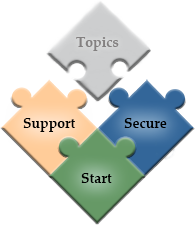-
The Categories and Steps of the I-Guides
The 10 steps (described below) are consistent across the I-Guides. They were created based on the implementation science research literature with input from policymakers and practitioners. (See: Research Basis). Although the I-Guides do not suggest a set order for preparing to implement programs or practices, the 10 steps are organized into three general categories: Start, Support, and Secure. Each component includes an introduction, recommended steps to take, examples from successfully implemented MPG programs, and additional resources.

- START:
- These steps relate to building a solid foundation before implementing an evidence-based intervention.
- SUPPORT:
- These steps assist with putting a program or practice into place.
- SECURE:
- These steps relate to stabilizing and sustaining the program or practice within the community or jurisdiction.
Start
Establish Clear Program Goals: Determine the outcomes you want to achieve. Define the metrics and data you will use to track performance, aid improvement, and measure results.
Conduct a Needs Assessment: Gather background information to learn about specific problems or gaps in programming related to what you want to accomplish. You may decide to conduct interviews, focus groups, or surveys of certain individuals or a community. Gaining a better understanding about what is going on will help you to:
- define desired results;
- set priorities;
- identify the resources available to improve or enhance services already available.
Supportive Research: Learn about the variety of programs and practices that address the change you are trying to realize.
Get Stakeholder Buy-In: Engage and earn support from those who will be involved in or affected by the implementation of a new program or practice, such as service providers, other agency staff, youth and families, community members, policymakers, and other leaders.
Identify Specific Jurisdictional Issues: Consider important characteristics of the jurisdiction or community that may affect implementation, such as setting (urban, suburban, rural), specific populations, political considerations, moral philosophies of stakeholders, and available resources.
Support
Procure Funding: Develop a feasible funding plan that considers public and private funding and other financing. Consider the real costs of operations even when they are supported by participating organizations or partners, including marketing, staff release time, start-up costs, and overhead.
Provide Program Training: Provide training to individuals involved with implementing a program as designed (or adapted). Trained individuals may in turn train others involved in implementation, which may help build internal capacity and ensure sustainability of a program.
Address Adaptation as Needed: Modify a program or practice model to fit the community’s specific needs while maintaining fidelity to the model. Consider the possibility of implementing specific program components instead of a whole program.
Secure
Handle Unanticipated Problems or Setbacks: Consider challenges or setbacks that may arise during implementation. Often, issues arise that are not considered or anticipated ahead of time. Establish a reporting or feedback process to help decision-makers learn from experience.
Ensure Long-term Sustainability: Even before implementing a program, it is important to consider how to maintain the program in the long run. Keep in mind the continuation of funding, ongoing training, capacity building, and scaling up effective programs.






